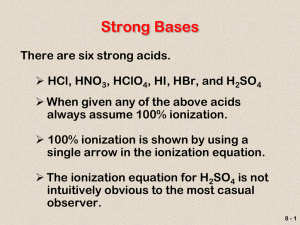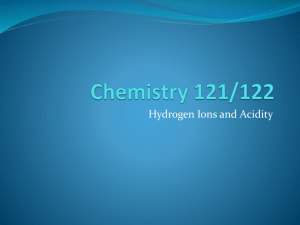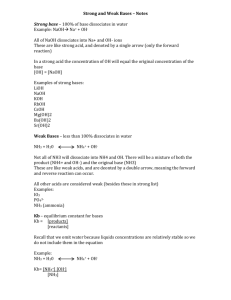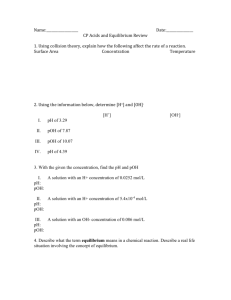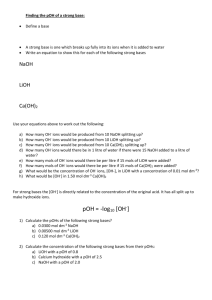lesson 14.5 acid and base equilibrium
advertisement
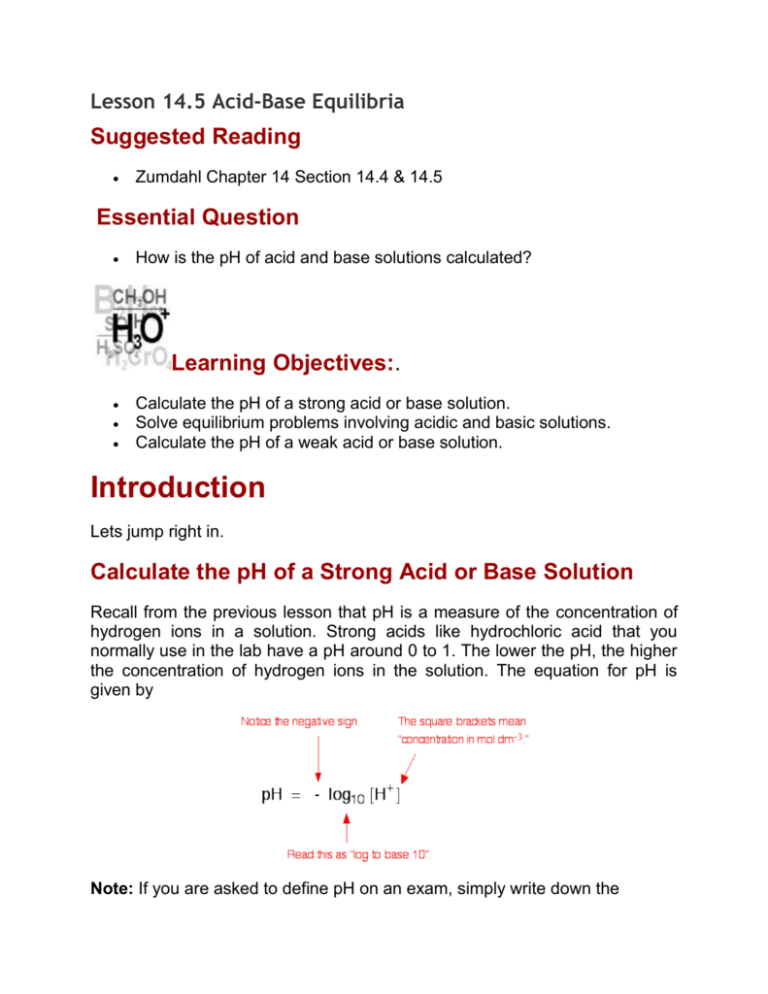
Lesson 14.5 Acid-Base Equilibria Suggested Reading Zumdahl Chapter 14 Section 14.4 & 14.5 Essential Question How is the pH of acid and base solutions calculated? Learning Objectives:. Calculate the pH of a strong acid or base solution. Solve equilibrium problems involving acidic and basic solutions. Calculate the pH of a weak acid or base solution. Introduction Lets jump right in. Calculate the pH of a Strong Acid or Base Solution Recall from the previous lesson that pH is a measure of the concentration of hydrogen ions in a solution. Strong acids like hydrochloric acid that you normally use in the lab have a pH around 0 to 1. The lower the pH, the higher the concentration of hydrogen ions in the solution. The equation for pH is given by Note: If you are asked to define pH on an exam, simply write down the expression in black. Never try to define it in words - it is a waste of time, and you are too likely to leave something out (like mentioning that the concentration has to be in mol dm-3). In the expression, above, the square brackets imply that, so you don't need to mention it. This is also true for other expression like the law of mass action, ideal gas law, etc. Suppose you had to determine the pH of a 0.1 mol dm-3 hydrochloric acid. All you have to do is work out the concentration of the hydrogen ions in the solution, and then calculate the pH. With strong acids this is easy. Hydrochloric acid is a strong acid - virtually 100% ionised. Each mole of HCl reacts with the water to give 1 mole of hydrogen ions and 1 mole of chloride ions That means that if the concentration of the acid is 0.1 mol dm-3, then the concentration of hydrogen ions is also 0.1 mol dm-3. Now use your calculator calculate the pH. pH = - log10 [0.1] = 1 The pH of this acid is 1. The pOH for a strong base is calculated in exactly the same way, except that you use the concentration of hydroxide ion. Calculate the pH of a Weak Acid In order to calculate the pH of a weak acids and bases, you first must determine the equilibrium concentration of the hydrogen or hydroxide ion. This involves setting up an ICE table just like you did in Chapter 14. The handout will walk you through it, but you should be familiar with the process. Read the following handout on calculating the pH of a weak acid at this web site: http://science.csustan.edu/stone/2090/2090ICE.pdf Calculate the pH of a Weak Base Weak Bases follow the general equation: Weak Base + H2O ⇌ conjugate acid + OH- Example: NH3 + H2O ⇌ NH4+ + OHThe equilibrium expression is given by Kb = [conjugate acid][OH-] [weak base] Example: Kb = [NH4+][OH-] [NH3] To calculate the pH of a weak base, we must follow ICE process, however, our solution will allow us to determine pOH. We must not forget to use the pOH to calculate the pH. Watch out for this! Example: Determine the pH of 0.15 M ammonia with a Kb=1.8x10-5 Answer: Write the equilibrium equation for the base: NH3 + H2O ⇌ NH4+ + OHWrite the equilibrium expression with the Kb value: Kb = [NH4+][OH-] = 1.8x10-5 [NH3] Ice it!: NH3 + H2O ⇌ NH4+ + OH - Ice: 0.15 M Change: -x Equilibrium: 0.15 - x ---- 0M +x x 0M +x x Substitute the variables (disregard the "-x" because it is so small compared to the 0.15) and solve for [OH-]: Kb = 1.8x10-5 = (x)(x) = x2 (.15 - x) .15 x = [OH ] = 1.6x10-3 M pOH = -log[OH-] = 2.80 pH = 14.00 - 2.80 - 11.20 - A dry but straightforward example of the problem type outlined above. Watch the following YouTube Video: https://www.youtube.com/watch?v=T679W7VjFAw HOMEWORK: PRACTICE EXERCISES 16.10-16.12, 16.15, 16.17 Book questions: (final review over everything from all ch. 14 lessons) Page 672 questions 5, 19, 25, 27, 29, 31, 32, 33, 37, 38, 41, 42, 43, 47, 59, 61, 99

